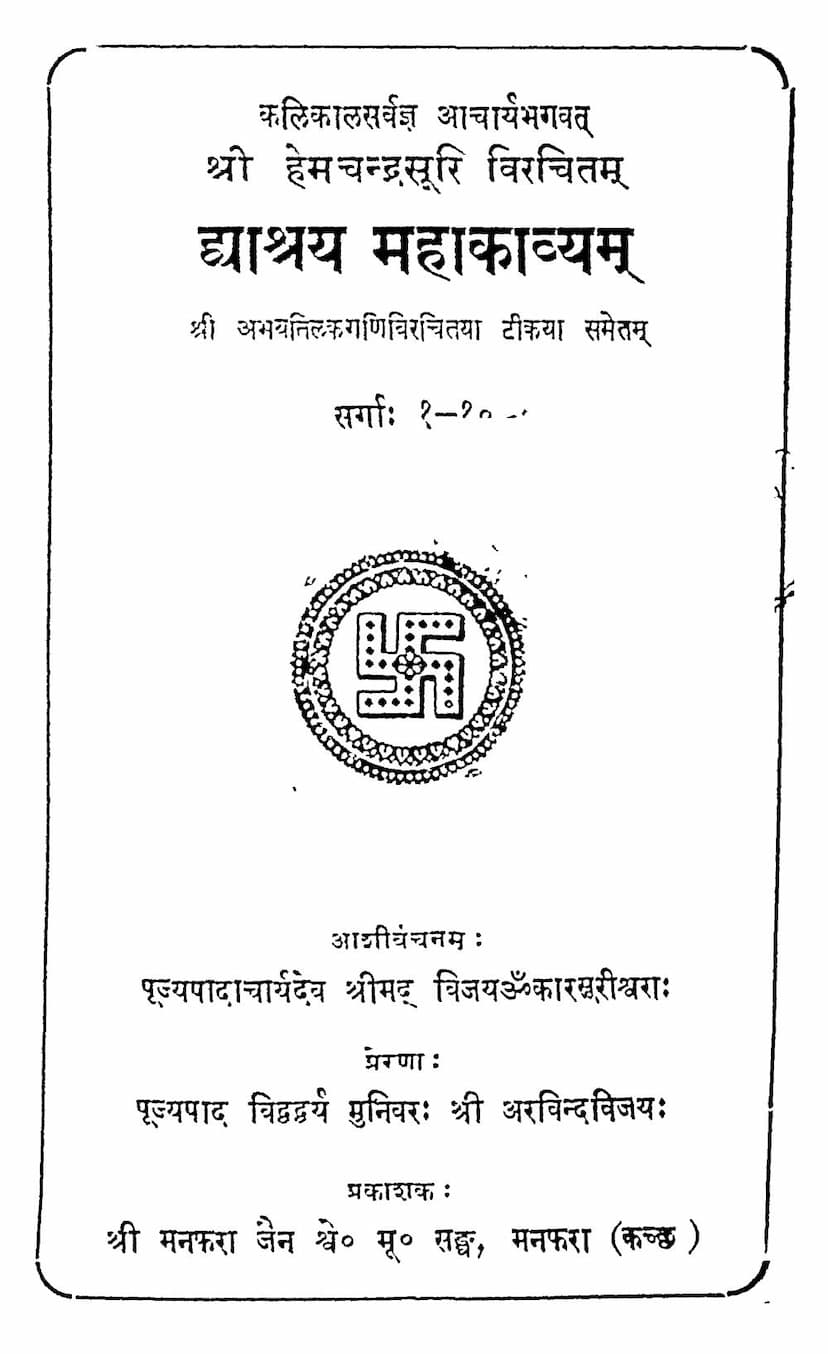Dwashraya Mahakavyam
Added to library: September 1, 2025

Summary
It appears you've provided the title page and the first few pages of a Jain text, "Dvyaashraya Mahakavyam" by Acharya Hemachandra Suri, with a commentary by Abhayatilaka Gani, published by Shri Manfara Jain Shwetambar Moortipujaka Sangh.
Based on the provided pages, here's a summary in English:
Book Title: Dvyāśraya Mahākāvya (द्वयाश्रय महाकाव्यम्) Author: Āchārya Śrī Hemachandra Sūri (कलिकालसर्वज्ञ आचार्यभगवत् श्री हेमचन्द्रसूरि) Commentary By: Śrī Abhayatilaka Gaṇi (श्री अभयनिलकगणि विरचितया टीकया समेतम्) Publisher: Shri Manfara Jain Shwetambar Moortipujaka Sangh, Manfara (Kutch) (श्री मनफरा जैन श्वे. मू० सङ्घ, मनफरा (कच्छ)) Language: Sanskrit (with Gujarati introductions and commentary) Period Covered (in Cantos 1-10): The text covers the history of the Chaulukya (Solanki) dynasty of Gujarat, from King Mūlarāja to Mahārāja Kumārapāla. Primary Purpose:
- Grammatical Illustration: The Mahākāvya is primarily composed to illustrate Acharya Hemachandra Suri's own monumental grammar work, the Siddhahaima Śabdānuśāsana (सिद्धहेम शब्दानुशासन). The title "Dvyāśraya" (Dvaya + Āśraya) signifies this dual purpose – serving as a basis for grammar and for history. 2' Historical Documentation: It serves as a significant historical record of the Caulukya rulers of Gujarat, detailing their lineage, administration, policies, and significant events like invasions and conquests.
- Poetic Excellence: While serving a didactic purpose, it's also a Mahākāvya (great epic poem), employing poetic conventions and descriptions of nature, cities, and human sentiments, although the primary focus remains on grammar and history.
Key Figures and Concepts Mentioned in the Provided Pages:
- Āchārya Hemachandra Sūri: Referred to as "Kalikālasarvajña" (कलिकालसर्वज्ञ - omniscient of the Kali Age), a highly revered Jain scholar, grammarian, philosopher, historian, and poet. He was born in 1088 AD and initiated into Jainism at a young age. His contributions spanned multiple fields.
- Abhayatilaka Gaṇi: The commentator of the Mahākāvya, whose insightful commentary helps in understanding the grammatical and historical nuances.
- The Publishers: Shri Manfara Jain Shwetambar Moortipujaka Sangh's effort in reprinting this valuable and previously unavailable text is highlighted, fulfilling their religious duty ascribed to by ancient texts.
- The Chaulukya Dynasty: The history of this prominent dynasty in Gujarat, rulers like Mūlarāja, Siddharāja, and Kumārapāla, are central to the narrative.
- Siddhahaima Śabdānuśāsana: Hemachandra's comprehensive grammar that integrates Prakrit grammar into Sanskrit, making Prakrit a part of the classical linguistic heritage. The Dvyāśraya serves as a practical application of this grammar.
- Dual Purpose (Dvyāśraya): The text's name itself emphasizes its unique contribution in simultaneously illustrating grammar rules and recounting historical events.
- Historical Details: The introduction mentions that the poem covers kings from Mūlarāja to Kumārapāla, including descriptions of their administration, policies, and specific events like the invasion of Somanātha by Mūlarāja.
- Grammatical Focus: The text aims to provide grammatical illustrations for all parts of Hemachandra's grammar, including Sanskrit and Prakrit grammar, by embedding examples within the narrative.
- Social Reforms: Hemachandra's role in implementing social reforms, such as abolishing animal slaughter and wine selling, and preventing confiscation of property, is noted.
The provided pages also contain blessings and dedications from prominent Jain figures, indicating the auspicious occasion of the book's publication. The detailed index of the first ten cantos further illustrates the historical and grammatical scope of the work.
In essence, the Dvyāśraya Mahākāvya is a monumental work that masterfully blends linguistic scholarship with historical narrative, preserving the rich heritage of the Chaulukya dynasty and the profound contributions of Āchārya Hemachandra Sūri.